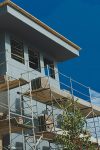Air Barriers
Important considerations for material selection and code compliance
By Tom Gangl
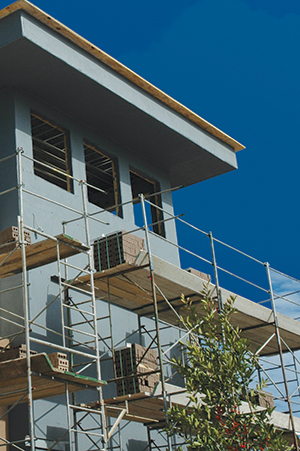
Masonry-clad buildings leak. They leak air, vapor, and water. These leaks place an environmental load on the building envelope, structural components, mechanical systems, and even building occupants. If left unchecked, these loads can result in building component and system failures. To prevent such failures, barrier systems are used to stop or at least control the leaks. While it is logical to use the correct barrier system for the job at hand, sometimes we don’t.
Air barriers first appeared in cold climates, where vapor barriers were employed in wall systems. By combining the air and vapor control, the air-vapor barrier (AVB) was born. Of course, a vapor barrier is really a Class-I vapor retarder, considering that even the quintessential “vapor barrier” — 6-mil poly — has some degree, albeit low, of moisture vapor permeance.
As their benefits became widely recognized, air barriers moved beyond cold climates and into more temperate zones. Along with this migration came the adaptation of vapor-permeable air barriers. Interestingly, the term AVB stuck. Some people still refer to the air barrier — even the vapor-permeable variety — as an AVB. This habit underscores the trap that designers and constructors can fall into, thinking that all barriers are the same. Let me be clear: not all barriers are created equal. To avoid the trap, it may be best to consider the functions of each barrier, exclusive from one another, before combining barrier systems to gain design and construction efficiencies on the wall.
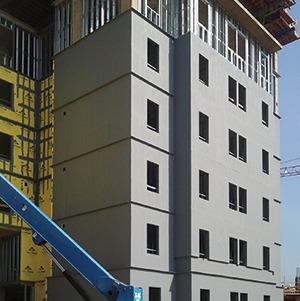
While the different physical forms that barriers take — mechanically fastened sheets (wraps), sheet-applied membranes (SAs), fluid-applied membranes (FAs), board-stock (BS), and spray polyurethane foam (SPF) — may be obvious, their capabilities are often less clear. The inaccurate reference to vapor-permeable air barriers as AVBs notwithstanding, the ambiguity around barriers is particularly evident when it comes to air and water-resistive barriers (WRBs). Air barriers are not the same as WRBs.
Consider this for a moment: air barriers are addressed in the International Energy Conservation Code (IECC), while vapor barriers and water-resistive barriers are addressed independent of one another in the International Building Code (IBC). These two different codes address functionally different barriers. Makes sense, doesn’t it?
To state the obvious: air barriers stop — or, more precisely, retard — air. To achieve an acceptable level of whole-building air tightness, air barrier materials defined in the 2012 IECC sec. c402.4.1.2.1 as having an air permeance of ≤0.004 cfm/ft² @ 0.3-inch w.g. when tested per ASTM E2178 are integrated using accessory materials to create assemblies. These assemblies, per the IECC, shall have average air leakage not to exceed 0.04 cfm/ft² @ 0.3-inch w.g. when tested per ASTM E 2357, ASTM E 1677, or ASTM E 283.
Another requirement of air barriers is continuity throughout the thermal envelope. Joining these assemblies together in a continuous, air-tight manner is essential and means that contractors don’t install an air barrier system. Rather, they create one using air barrier materials. The air barrier system, when properly constructed in the field, resists air flow in both directions and works to keep conditioned air inside the environmental separator and prevent outside, unconditioned air from leaking past it. The benefits of a properly designed and constructed air barrier system include greater occupant comfort, improved indoor air quality (IAQ), reduced HVAC cycling, and efficient (lower-cost) equipment performance, not to mention code compliance. In addition, because air is a highly effective transport mechanism for water vapor (but not the only mechanism), a second benefit can be realized: keeping airborne water vapor out of wall assemblies. This is a good thing because sometimes water vapor turns into liquid water as it cools to its dewpoint, affecting hygroscropic or water-sensitive building materials. For example, wood rots, steel rusts and gypsum crumbles.
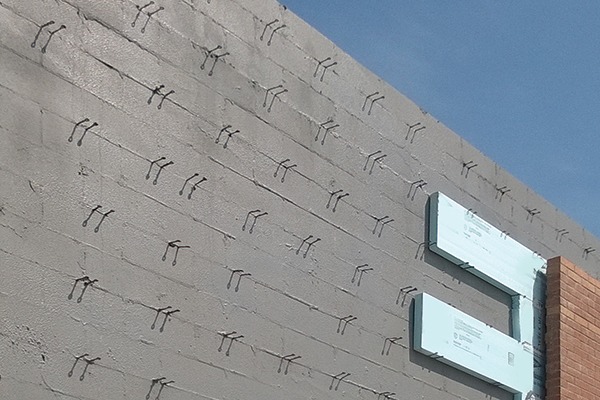
This secondary benefit of air barriers — keeping wall assemblies dry — while valuable indeed, is actually the primary role of another unique barrier: the water-resistive barrier (WRB). WRBs predate air barrier usage in U.S. construction codes by several decades. Consistent with the concept that all barriers are not created equal, it makes sense that IECC building code requirements for air barriers are different than IBC requirements for water-resistive barriers. For example, the IECC allows air barrier placement anywhere within the thermal envelope. In contrast, the IBC directs the installation of WRBs over the exterior face of sheathing.
By keeping sheathing dry after water leaks past the primary cladding (and it will), the WRB, along with flashing, represents the second defense against water. The third defense against moisture remains the air barrier, which is designed to stop air that may be moisture-entrained and can potentially side-step the WRB, which may lack the inherent capacity to sufficiently retard moisture-laden air. Since WRBs are intended to stop water (not air), it should not be surprising that WRBs are tested to an entirely different set of standards than air barriers.
Despite the WRB’s long-established role in keeping wall assemblies dry, sometimes an air or air/vapor barrier is mistaken for a water-resistive barrier and installed in its place. Installing an air barrier in place of a water-resistive barrier is a bad idea. I liken it to wearing flip-flops instead of boots on a construction site.
Indeed, most manufacturers of sheathing and cladding – the wall assembly components most often in closest proximity to an installed air barrier — make little or no reference to air or vapor barriers but include explicit requirements for a water-resistive barrier in their framed construction details, installation guidelines, and warranty literature. Lest these manufacturers’ redundant pleas for a WRB are ignored, the IBC calls for the use of an “approved” water-resistive barrier over sheathing (ICC-IBC 1404.2). Suffice it to say, mistaking the air barrier as the WRB is ill advised. Just because a particular air barrier can be installed on a sheathed wall doesn’t mean it should be installed without proper qualification.
This is a particularly salient point when it comes to fluid-applied air barriers. These systems have grown in popularity, and justifiably so, given their relatively low cost, ease of achieving high-quality installation, and time-tested ability to avoid displacement (not just during the construction phase but over the service life of the building), among a host of other benefits. However, a fluid-applied air barrier product that is not specifically identified as a WRB by the manufacturer probably has not been evaluated to perform as a WRB per ICC-IBC Sec. 1404.2.
Because a fluid-applied material comes out of a bucket or drum, it lacks brand and other identifiers once installed on the wall. Likewise, unfortunately, it lacks any code compliance references on the wall.
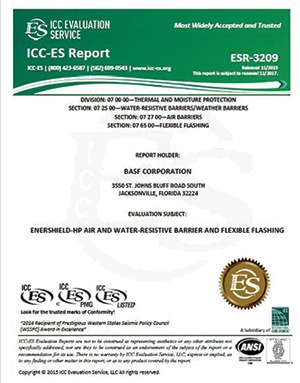
Image courtesy of International Code Council.
To realize the benefits of a fluid-applied air water-resistive barrier (AWRB), the barrier must be capable of performing both air and water control in an installed environment. The IECC requirements for air barrier materials and assemblies are limited to air control. To validate the performance of fluid-applied barriers as water-resistive barriers, ICC Evaluation Service has established Acceptance Criteria 212. ICC-ES AC-212 for a Water-Resistive Coating to be used as a Water-Resistive Barrier on Sheathed Construction. To pass the acceptance criteria is to pass the ICC-ES’s stringent third-party testing, which transcends a manufacturer’s sample tests in a lab and includes structural, racking, restrained environmental conditioning, and water penetration testing of entire assemblies. This comprehensive test set addresses the recognized conditions observed on framed assemblies, which is precisely where WRBs have been called into use by building codes for decades. To be sure, the behavior of a framed wall is demonstrably different than that of a below-grade or above-grade CMU wall when considering the cyclic and transverse loads imposed upon these assemblies. If a fluid-applied WRB system is capable of maintaining integrity and withstanding water penetration through all these tests, it becomes recognized as a WRB by ICC-ES through the issuance of a code-report — also known as an ICC-Evaluation Service Report (ICC-ESR). This report provides evidence to the public as well as code officials worldwide that the named barrier performs as a WRB as called for in IBC 1404.2.
When selecting materials for sheathed wall projects, where WRBs are required per the building code, one can properly identify fluid-applied air barriers that are also WRBs by going directly to the qualifying body, the ICC Evaluation Service. On the ICC-ES website, www.icc-es.org , simply follow the link for evaluation reports and search by manufacturer or product to correctly ascertain whether a particular fluid-applied air barrier meets the ICC-ES requirements of a WRB.
You can also visit www.enershield.basf.com to learn more about Enershield fluid-applied air/water-resistive barriers. This product is not only an IECC and Air Barrier Association of America (ABAA) qualified air barrier, but after extensive independent third-party evaluation, is also recognized as a water-resistive barrier by ICC Evaluation Service LLC and meets the WRB requirements in IBC-1404.2.
Tom Gangl is market segment manager, BASF Corp., Construction Systems. He can be reached at tom.andrew.gangl@basf.com.
